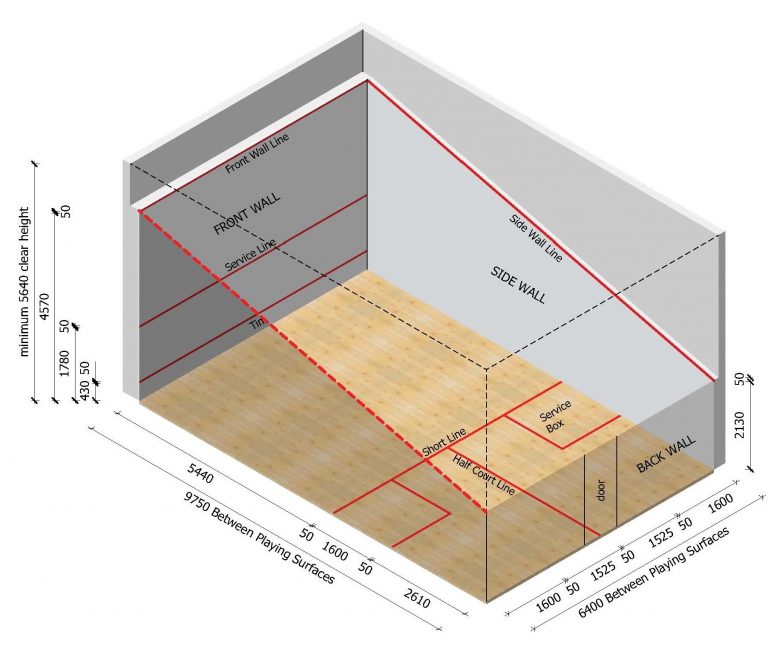‘How do we play this game? What are the rules? – these are the frequent queries from beginners and starters when they pick up this game. Squash as a sport has still has not received media and corporate buy-in and as a result the awareness of this game is quite low. Though to set up a squash court does not take much in terms of space and effort – the penetration of this game in terms of viewership and followers are still quite low. Some of the basic rules of squash are highlighted below.
Rules of Singles Play Squash
This post talks about the rules for singles play only, for doubles play it becomes more complicated and intense.
The Serve

This is the starting point of the rallies and it is done from the service box (5′ 3″ square area). (See adjoining figure) .
While starting the serve or after winning a point, the server can choose from which side to start the serve. However while retaining a point after a rally, the server must serve from the other box. While serving at least one foot (partially is fine) should be in contact with the floor inside the service box
The Game
Once the service is done the rally starts till the point is won. For a shot to be valid a) it should hit the front wall between the tin and upper line at least once and b) the ball can bounce a maximum of one time on the floor before the opponent can hit his/her shot. After a point is won, the server changes sides if he/she wins the point or the opponent can choose from which side to serve if he/she wins the point.
Point System
Each rally won is 1 point. Each game consists of 11 points and there should be a at least a difference of 2 points. In case its 10-10, it will go into a tie-break which means play continues on till there is a difference of 2 points.
PARS – The point-a-rally is known as the PARS system. The PARS to 11 is currently the official adopted system used in game. The PARS to 15 was used in the World Championships between 1989 and 2003. From 2004 onwards the Professional Squash Association (PSA) under the aegis of World Squash Federation (WSF) decided to adopt to PARS-11 system of scoring.
English – HiHo Scoring
The was the scoring system predominantly played in England. Each game consisted of 9 points and points can be only be won on serve only. In case you lose a point on serve, the ball is ‘handed-out’ to the other player. This point system lost out to the newer system as the games would go on for long and there was no way to anticipate/plan for the game times.
Let/Stroke
During a rally a ‘Let’ and a ‘Stroke’ can be called to stop play. Since both the players are playing in close quarters and squash itself being a fast game, ‘let’s and ‘strokes’ are very common during the play. A player finding the interference from the opponent can decide to play on or stop play – it is advisable to stop play to prevent any injuries from happening.
Let – A let is an undecided rally – the rally does not count and it is played out again, with the server serving from the same box. A player is entitled to a let if he/she could have returned the ball and the opponent has made every possible effort to avoid the interference. If the rally is indeed awarded a ‘Let’ , the officials will give a visual sign with their hand making an ‘L’ shape with their thumb and index finger.
Stroke – The player is awarded a ‘stroke’ (wins the rally) if either
- a) if the opponent did not make every effort to avoid the interference or
- b) if the player would have made a winning return if not for the interference or
- c) the player would have struck the opponent with their shot going towards the front wall
The rules of interference are quite complex and often the ruling are subject to the experience and expertise of the match officials
Rules for Turning
Since Squash gives the unique ability of hitting any of the 4 walls as part of their shot, the rules behind turning are very important. Here’s what the WSF recommends on turning –
‘If the striker has either followed the ball round, or allowed it to pass around him or her – in either case striking the ball to the right of the body after the ball had passed to the left (or vice-versa) – then the striker has “TURNED”. If the opponent is struck by the ball after the striker has turned, the rally is awarded to the opponent. If the striker, while turning, stops play for fear of striking the opponent, then a let is played’. See if you can officiate the turning showed in the video between Gaultier v/s Ghosal
Warm-up and Between Games
As per WSF, a maximum of 90 seconds is permitted between each games and also between the end of warm up and start of the game.
Warm-Up – Before the start of the match a maximum warm-up time of 5 mins is given and the players have to change sides after 2 1/2 mins of warm-up.
Match Officials
A match should normally be officiated by a Marker and a Referee, both of whom should keep track of the score, correct service box etc.
The correct position of the officials is to be seated at the center of the back wall and as close as possible to the out line.
Do check out our other articles on the Court Dimensions and Squash Rules Refresher before starting out this game. Also there are articles on Squash Racquet Buying Guide and Different Shots in Squash as an assist to better your game.
